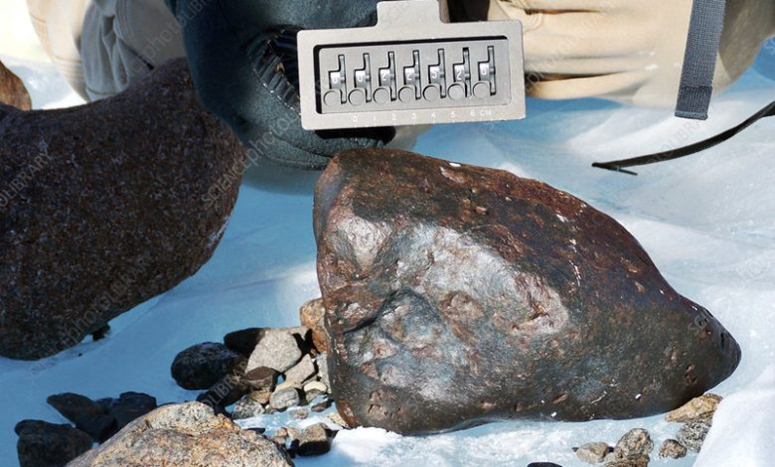The largest meteorite found in the last century in Antarctica

Meteorite discovered in Antarctica. Field image of a large meteorite found during the 2014-15 US Antarctic Search for Meteorites program (ANSMET) season. The field numbers in the image are used for tracking and inventory purposes. The meteorites are analysed and their mass and composition recorded. ANSMET has collected thousands of meteorites since it began in the 1970s, with the majority of them being of a stony (non-metallic) type known as chondrites. The specimens discovered in the 2014-15 season were all from the blue ice fields along the Transantarctic Mountains.
Antarctica is a prime destination for scientists when it comes to searching for meteorites. The dark stones stand out clearly due to their contrast with the icy ocean. In addition, its dry climate reduces erosion factors to a great extent. Even when meteorites sink through the ice, crashing glaciers often bring them back to the surface.
Despite all these ideal conditions, it is rare to find large pieces of meteorite rocks.
But recently, a group of researchers returned from Antarctica with five new meteorites, including one larger than usual.
The stone weighs 7.6 kilograms, making it among the 100 largest samples of meteorites brought back from Antarctica over the past century. The importance of this can be understood if we know that about 45,000 samples were brought back from Antarctica during that time.
This large space stone will be returned to the Royal Belgian Institute of Natural Sciences, where it will be carefully studied along with other smaller stones. Researchers can learn a lot about the journeys meteorites went through before arriving on our planet.

“Size may not matter when it comes to meteorites,” says Maria Valdez, an astrochemist at the Illinois Museum of Natural History. “Even small meteorites can be of great scientific value, but finding a meteorite as large as this is really rare and exciting.”
Although spotting meteorites in Antarctica is easier than elsewhere, traveling across the continent is not so easy, given its isolated location and extremely cold climate. The team behind the discovery spent several days camping out in the open, traveling on foot or using snowmobiles.
It is useful to know the possible locations of meteorites. The researchers used a map published last year that uses evidence from satellite images, including ice flow, heat and surface slope measurements. , to obtain informed predictions of the locations of meteorite rocks, with the help of artificial intelligence.
“It's exciting to go on an adventure to explore unknown areas, but we have to deal with the fact that working on the ground is very different from working with satellite images,” says Vincent DeBelle, a geologist at the Université Libre de Bruxelles.
The map the researchers used is estimated to be about 80% accurate in terms of directions, and its creators estimate that there are more than 300,000 meteorites yet to be found in Antarctica.
Researchers believe that we are overlooking many meteorites, especially those rich in iron, despite the favorable conditions for searching for them in Antarctica. This is partly because this type of meteorite heats up in the sun's rays, melting the surrounding ice and sinking beneath the surface.

There's a new payload of meteorites waiting to be studied more carefully, and the new rocks should bear traces of our solar system's history.
“The bigger the sample we have, the more we can understand our solar system, and ourselves,” Valdez says.
Source: Science Alert - Translation: ibelieveinsci

